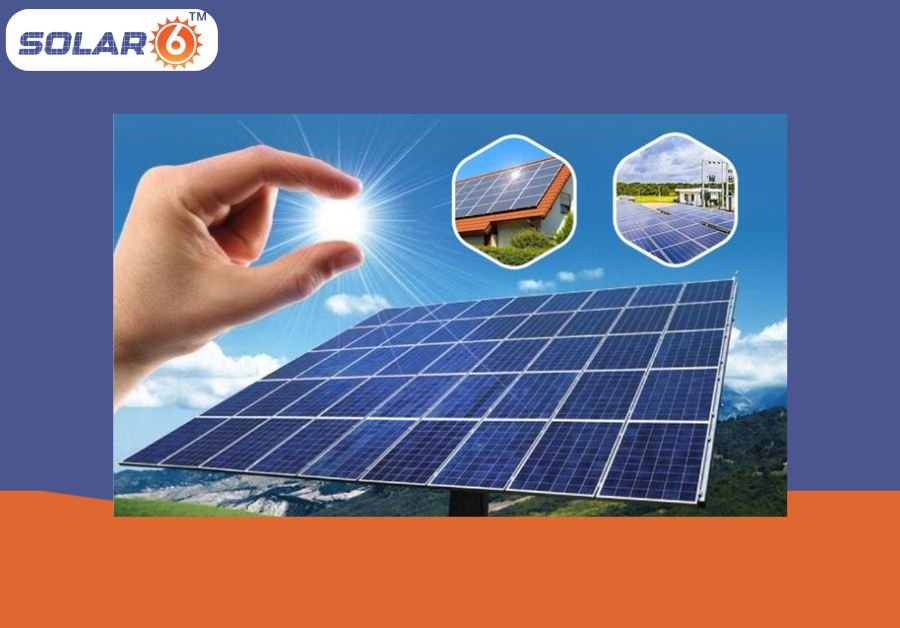Switching to solar power is one of the smartest investments you could make for your own home or enterprise. Whether you’re looking to reduce energy bills, become more environmentally responsible, or increase your home’s value, installing a solar panel system is an impactful leap forward. However, the upfront value of solar panel installation can be enormous, and that’s where solar loans come into the picture.
Financing your solar transition through a loan makes clean power more accessible; however, it’s not a decision to be made lightly. From interest rates and loan terms to eligibility and hidden costs, information about what you’re signing up for is important. In this Article, solar6 explores the 5 most important things you must recognize before taking a solar loan, whether or not you’re thinking about it for a residential solar setup or a massive-scale business solar mission.
1. Understand the Types of Solar Loans Available
Before diving into any loan agreement, it’s essential to know the types of solar loans available. Typically, solar loans fall into three main categories:
Secured Loans
These loans require you to put up an asset, such as your home, as collateral. Because the lender has something to fall back on, secured loans usually come with lower interest rates and longer repayment periods.
Unsecured Loans
Unlike secured loans, unsecured loans don’t require collateral. However, the risk is higher for lenders, which usually results in higher interest rates and shorter repayment terms.
Home Equity Loans or Lines of Credit (HELOCs)
These are ideal for homeowners who have sufficient equity in their property. Interest rates are relatively low, and the terms are often favorable. However, they still use your home as collateral.
Choosing the proper loan depends on your monetary situation, credit rating, and the scale of the solar installation. For instance, commercial solar initiatives may additionally benefit greater from secured commercial enterprise loans, while residential solar structures might be financed through personal or unsecured loans.
Whether you’re trying to strengthen your home with rooftop solar or energize your enterprise facility with an extensive device, deciding on the proper financing choice can set the tone for long-term achievement.
Solar6 gives professional guidance tailored to your solar mortgage wishes, assisting owners and groups navigate their options with readability and confidence.
2. Check Your Eligibility and Credit Score
Your credit score plays a major role in determining not only your eligibility for a solar loan but also the interest rates and terms you receive. Most creditors pick a credit rating of at least 650 to offer aggressive fees, but a few specialized, inexperienced strength lenders are greater flexible.
What Affects Your Solar Loan Approval?
Credit History: A history of timely repayments improves your chances.
Debt-to-Income Ratio: Lower ratios are desired with the aid of creditors.
Income Stability: Regular earnings assure creditors of your reimbursement capability.
Existing Debts: If you already have multiple loans, this could impact your approval.
If you’re considering a solar panel installation through a local provider like Solar6, they often partner with financial institutions that offer solar-specific loans. These partnerships can streamline the process and sometimes provide better terms than general consumer loans.
Your loan eligibility could also vary depending on whether it’s for residential solar or commercial solar systems. Businesses may need to present additional documentation, like cash flow statements or balance sheets.
Regardless of your loan type, having a good understanding of your financial health will help you secure the most beneficial terms for your solar energy investment.
3. Calculate the Total Cost – Not Just the EMI
One of the most common mistakes people make when taking a solar loan is focusing solely on the monthly EMI (Equated Monthly Installment). While knowing your monthly payment is crucial, it’s just one piece of the puzzle.
What Should You Include in Your Total Cost Calculation?
- Loan Processing Fees
- Interest Over the Loan Tenure
- Prepayment or Foreclosure Charges
- Installation and Maintenance Costs
- Warranties and Insurance
You must also component in the long-term financial savings from reduced energy bills. For instance, a great rooftop solar device can lessen your house’s electricity charges by way of 70–90%, and industrial solar setups can result in even larger financial savings, particularly in high-utilization industries like production or hospitality.
Additionally, solar structures frequently qualify for government incentives and tax benefits, which can considerably reduce your overall expenditure. Some economic establishments additionally will let you bundle these incentives into your loan, making repayment easier.
Solar6 affords customers with obvious pricing and enables them to check the full fee of ownership, including warranties, upkeep, and expected returns. This approach ensures you are not stuck on the shield through hidden costs or unrealistic ROI projections.
Whether you’re investing in solar energy for personal use or scaling up operations with commercial solar, understanding your complete cost breakdown is critical for making a sound financial decision.
4. Evaluate the Loan Tenure and Interest Rates
Your loan tenure—the duration over which you repay the loan has a direct impact on your monthly EMI and the total amount paid in interest. Longer tenures reduce EMIs but increase the overall interest paid, while shorter tenures do the opposite.
Points to Consider:
Balance Monthly EMI with Your Budget: Don’t overburden yourself with high monthly payments.
Check for Floating vs. Fixed Interest Rates: Fixed rates offer predictability, while floating rates may fluctuate.
Ask About Prepayment Options: Some lenders charge penalties for early repayment; others don’t.
Compare Multiple Lenders: Don’t settle for the first offer you receive. Explore banks, NBFCs, and green energy financiers.
A typical solar loan tenure ranges from 5 to 15 years, depending on the loan amount and your repayment capacity. For residential solar, shorter tenures may be more manageable, while commercial solar projects often require longer terms due to the larger loan amounts.
Interest rates for solar loans can range between 8% and 14%, though specialized green energy financing may offer better terms. It’s essential to calculate the total interest cost over the life of the loan, not just the initial EMI.
Solar6 collaborates with vetted financing partners to offer competitive rates and flexible tenures for both residential and commercial solar customers. Their end-to-end support ensures a smoother experience from loan application to final solar panel installation.
5. Choose a Reliable Solar Provider and Financing Partner
Taking a solar loan is not just about getting the funds; you also need a trustworthy provider to ensure that your solar energy system is efficient, reliable, and properly installed.
Why Your Solar Provider Matters:
System Quality: Tier-1 solar panels and inverters offer better performance and longer lifespan.
Installation Expertise: Proper installation affects both system efficiency and warranty validity.
After-Sales Service: Timely maintenance and support are essential for long-term performance.
Accurate ROI Estimates: Reliable providers offer realistic projections based on your usage and location.
Many reputed solar companies like Solar6 offer bundled packages that include consultation, design, rooftop solar installation, maintenance, and even financing assistance. This integrated approach removes the hassle of coordinating between different vendors and ensures accountability.
If you’re investing in commercial solar, working with an experienced provider becomes even more important. Commercial setups often require custom design, high-capacity inverters, and grid synchronization—all of which demand technical expertise.
Always verify the credentials of both your solar provider and financing institution. Check online reviews, ask for customer testimonials, and review their past projects. Ensuring quality today can save you from costly repairs or inefficiencies down the line.
Conclusion:
Empowering Your Solar Journey with Smart Financial Choices
Taking a solar loan is a sensible way to get right of entry to clean, renewable power without the weight of upfront costs. However, like every monetary determination, it calls for cautious attention and due diligence. Understanding the forms of loans, assessing your eligibility, calculating the general fee, comparing the hobby costs and tenures, and deciding on the right business enterprise are all essential steps in making an informed decision.
With the proper financing and a dependable solar partner like Solar6, your transition to solar energy may be easy, less expensive, and impactful. Whether or not you’re powering your private home through residential solar, growing operations with commercial solar, or taking a step with a small-scale rooftop solar installation.
As solar adoption continues to grow for the duration of India, more residential property owners and groups are understanding that the sun isn’t just a source of moderate it’s a pathway to energy independence and prolonged-time period economic savings.
So, if you’re considering going solar, start with the right records, make clever financial options, and trust in dependable companions that will help you along the way. Your sustainable future begins with one informed choice.

